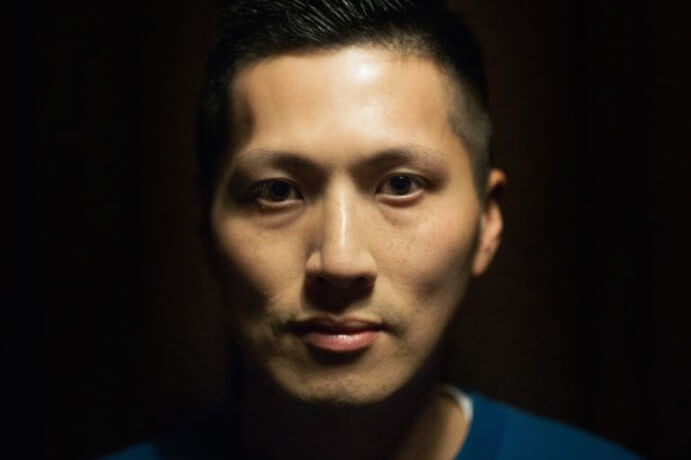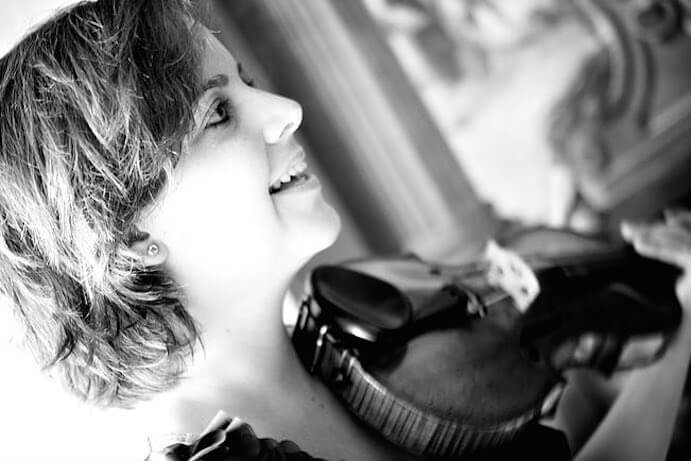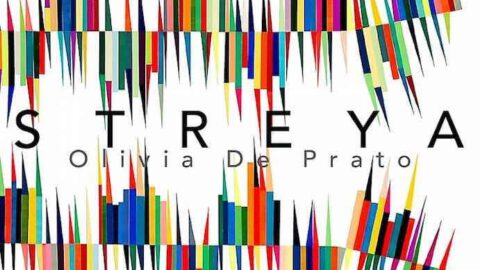Against a clean white background, vibrantly-technicolored, jaggedly-arranged rectangles and triangles form two mirrored waves. The radical juxtaposition of color and form leads the eye quickly along many different paths, generating depth from previously simple form and color. The cover art for Streya, created by Jessica Slaven, perfectly captures the playful yet precise spirit of violinist Olivia De Prato’s debut solo album.
Released in March 2018 through New Focus Recordings, Streya combines six works for solo violin from composers whose disciplinary backgrounds are as a diverse as its cover. De Prato brings a unique and authentic character to each performance, drawing from a career of experiences built upon a similar heterogeneity. Superb mastering and editing of acoustic and electronic material by Jeffrey Svatek heighten and clarify the stylistic particulars of each track.
The album opens with the noisy overpressure double stops and percussive electronic sounds of Samson Young’s Ageha.Tokyo. Young’s work is richly allusive, sonically referring to the dual meanings of its title: a swallowtail butterfly, and Tokyo’s largest gay night club. The electronic sounds shift from glamorous drones and delicate bells, to gritty noise descending to deep, pulsating bass beats. De Prato’s playing serves as a counterpoint, agilely moving in and out of each of these textures with floating melodies and complementary noisy effects. Enjoyable as a catchy “pop tune” or as a scintillating art work, this might just be the new music song of the summer.

While composing Streya, Victor Lowrie imagined observing the formation of giant celestial bodies, millions of light years away from Earth. Lowrie realizes this vision through subtle timbral and dynamic variations of repeated melodic gestures and harmonic structures. His writing demonstrates a familiarity with both instrument and player, showcasing the explosive power and delicate subtly of De Prato’s technique. The intimate and exacting recording quality renders each phrase in high contrast against a stark, minimally reverberant space.
Ned Rothenberg’s etude Percorso Insolito depicts a colorful journey of an imaginary De Prato hiking through an idyllic, yet subtly fantastical countryside. The adventurous and winding musical narrative draws upon Rothenberg’s own improvisatory style as a multi-instrumentalist. De Prato’s keen sense of phrasing guides the listener through Percorso insolito’s opening angular melodic lines, her pacing increasingly heightening a sense of wandering and discovery. Along the way, the introduction of double stops, soaring harmonics, and resonant pizzicato to the milieu allude to increasingly interesting terrain filled with lush foliage. Reaching the peak of a climb, De Prato briefly dazzles using all of these techniques simultaneously. This moment lasts but an instant. The previously covered musical ground is retraced, ending the journey quietly as it began
Wane, by Taylor Brook, begins with a series of entrancing melodic phrases played by a single solo violin. All of the sudden, this voice is joined by four pre-recorded violin parts, each tuned at a slightly lower microtonal tuning. Punctuated by returns to this opening solo texture, the ten-minute work moves through a number of increasingly dense, undulating, microtonal textures, which creates a pleasantly disorienting effect as the ear struggles to account for the number of voices playing. De Prato expressively navigates the dizzying and captivating work in a manner which feels almost improvised, a testament to her interpretation and Brook’s composition.

Reiko Füting’s Tanz.Tanz pays homage to Haruki Murakami’s novel Dansu Dansu Dansu as well as Chorale tunes discovered by Helga Thoene in J.S. Bach’s Chaconne in D minor. Combining echoes of Bach’s formal structures with a surreal timbral language inspired by Murakimi’s novel, Füting’s work is a more overtly intellectual exploration. Motives ornamented in a style reminiscent of traditional Japanese Kokyu are methodically developed in timbre and dynamic. De Prato’s interpretation delivers the essence of this synthesized style through a now familiar attention to detail and intelligent as well as nimble elegance in phrasing.
Closing out the album, Missy Mazzoli’s Vespers for Violin reimagines an earlier electroacoustic work, Vespers for a New Dark Age. The new work for solo violin and electronics has a cinematic quality, which evokes a sense of time and space suggested by its title. The electronic part creates a vast soundscape comprised of expansive organ samples, punctuated by wispy vocal and bell sounds. Against this backdrop, De Prato’s sensitive playing gently emerges with a combination of soaring melodies and shorter motives that fade away into the billowing electronic texture. In the context of the whole album, Vespers serves as a reflective moment at the end of an energetic and eclectic journey
Streya is musically artistically vibrant, and showcases De Prato’s diverse conception of new music. Like its cover art, the album as a whole is pleasantly accessible at first pass. However, to those willing to listen with curious ears, Streya remains satisfying, fresh, and rewarding in depth upon subsequent informed hearings.
























